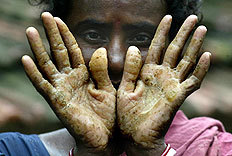
|
| ©Reuters |
| A Kolkata woman displays her wrinkled hands, caused by drinking arsenic-contaminated water. |
Arsenic is not merely a favourite resort of medieval or Victorian murderers and crime novelists. It causes cancer of the skin, lung, bladder, kidney, liver and uterus, is implicated in several skin diseases, nerve disorders, diabetes, lung disease and heart disease, and is suspected of causing birth defects, liver and blood disorders. In South Asia, women and girls who contract the symptoms are often expelled from their families, inflicting social and personal tragedy as well.
Arsenic poisoning for the most part results from human activity and is therefore preventable. In the case of Bangladesh and West Bengal, the source is chiefly the millions of household tube wells that aid agencies caused to be dug, so families could avoid polluted surface water by obtaining ostensibly clean well water.
This arsenic is geogenic: silt eroded from the Himalayas is high in arsenic which, through the millenniums, has accumulated in the sediments of the Gangetic Delta from which these wells supply household water for drinking, cooking and growing vegetables.
An estimated 70 million people are exposed to arsenic in India and Bangladesh alone, part of what must surely rate as the worst case of mass poisoning in history. Other countries with similar geologies, such as Burma, Cambodia, Laos and Vietnam, are also affected, though global awareness about these is lower.
The human toll of death and sickness from arsenic is unknown but certainly runs into the millions. The US National Research Council estimates that drinking a litre of water containing 50 micrograms of arsenic a day will cause 13 deaths out of every 1000 people. Often household wells have many times this level.
In countries such as Australia, New Zealand, South Africa and Argentina the main sources of arsenic are anthropogenic: the hundreds of thousands of century-old livestock dips scattered across the landscape and the residues from former goldmining tailings that leach arsenic into surface and groundwater. Old railway lines, treated timber plants, cotton farms and certain factory sites also contribute a toxic legacy on which suburbia often innocently sprawls.
Many Australian scientists have worked on different aspects of the arsenic problem and AusAID has run programs to provide safer water in several countries. In some cases the answer may be as simple as a rainwater tank. But for all the efforts of Australians and international agencies the problem remains intractable, only pecked away at the edges.
A recent development with some promise is the discovery by Megharaj Mallavarapu of the Co-operative Research Centre for Contamination Assessment and Remediation of the Environment and University of South Australia of a naturally occurring soil bacterium that oxidises the highly toxic arsenite to much less toxic arsenate. Megh says the microbe can be used not only to remediate badly contaminated soils but possibly also incorporated into a filter to cleanse household water from affected wells.
Other researchers, such as Ging Khoe at the Australian Nuclear Science and Technology Organisation, have devised different kinds of water filters using physical or chemical techniques. The CRC CARE team has also mapped the spread of arsenic through the Bangladeshi food chain.
Another important approach to the problem is one in which Australians are experienced and well qualified: catchment management. By planning and managing surface water better, there is scope to clean up contaminated surface water, which would reduce household dependency on toxic wells. There is also scope to reduce the arsenic content of the food supply by not irrigating with groundwater.
From these examples it is abundantly clear that Australians have the ideas and scientific capability to overcome this human crisis. What is missing is the large-scale vision to pull all these elements into a cohesive program. When Howard Florey developed penicillin as a useable drug, when Frank Fenner took on the task of banishing smallpox from the world and when Fred Hollows tackled eye disease in Australia and Africa, it required vision.
In the case of the world's worst poisoning episode, the vision to tackle and terminate it through a comprehensive scientific and aid program so far has not been forthcoming.
If Australia aspires to show leadership and to put its scientific skills to work to benefit humanity on the large scale, this is a task worthy of our mettle and within our capabilities and resources.
Julian Cribb is an adjunct professor of science communication at the University of Technology, Sydney and editor of www.sciencealert.com.au.



Reader Comments
to our Newsletter